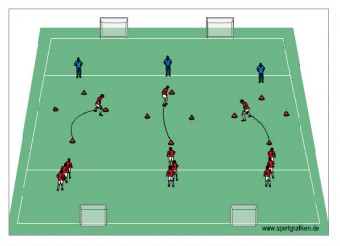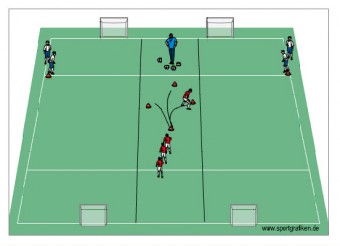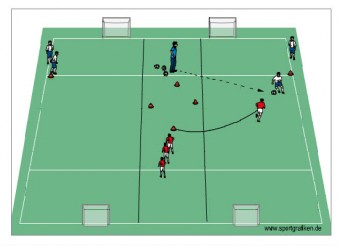Before deciding on “What system to play” or focusing on your team defending you must recognize that defensive success is first and foremost based on quality 1 vs. 1 defending. Getting pressure on the player with the ball is vital if the rest of the team is to carry out their defensive responsibilities. Only when this pressure takes place can the remainder of the players get “compact” and take away space from the attacking team. There are three key principles to successful 1 vs. 1 defending:
- Quick Pressure-The player nearest the ball must “close the space” as quickly as possible as soon as the ball is played to his opponent. You should close ground on your opponent as the ball is traveling to the attacker, do not wait until he/she has received the ball. Defender has three priorities:
- Intercept the Pass- if you can anticipate the attackers’ actions, but never commit to this unless you are sure you can get there.
- Challenge the First touch- Be in a position that you can “steal” the ball off of a poor first touch.
- Contain the attacker- Deny space to turn or pass in a penetrating manner.
- Touch Tight Pressure- When closing down space, it is important that you don’t overrun the play. As a rule you should slow down about 5 yards from the attacker and gradually take away the remaining space in a controlled defensive position.
- You want to be in a position that the attacker feels uncomfortable, and if he makes a mistake you can win the ball.
- You are close enough that you limit the attackers’ vision of the field.
- You cut off forward passing lanes, making play more predictable for your supporting defenders.
- Patient Pressure- Good defenders will recognize that they do not need to win the ball immediately. If you approach the attacker quickly and under control, taking away his space, you will shift the initiative to the attacker. Most attacking chances are created through poor and impatient defending. General rules for “Patient pressure” are:
- Don’t Dive In
- Be Cool and Alert- Ready to take the ball when it’s exposed
- Tackle with Confidence- Be quick enough to poke the ball away or hard enough to send the ball forward through the attacker.
Something to consider- One of the best times to win the ball back is in the moments after you’ve given away possession. If you can get immediate pressure on the ball from the defensive player closest to the ball, often the player who just lost it, the attacking team won’t be as organized and will likely turn the ball over. In a worst case scenario you can eliminate their ability to play forward.
Common Mistakes in Young Defenders
- Failure to get touch tight. Concede too many options to the attacker (shots, penetrating passes, etc.)
- Failure to show patience. Try to win the ball too often and too early. Defenders need to learn to control their momentum. Let the attacker make a mistake and then pounce.
- Poor Transition. Young players drop their heads on loss of possession and leave their teammates prone to the counter-attack.
Summary: As you can see the role of the first defender is vital to the success of team defending. If we do a poor job in applying pressure to the ball and taking away the attackers options the whole defensive system will suffer. It is very important that we spend time teaching each player the principles of individual defending. The 1 vs. 1 is the foundation of the game. This doesn’t just apply to the attacking principle, but defensive as well.
Here are a couple of exercises to teach proper 1v1 Defending appropriate for all ages.
Dick Bate Defending Diamond
 The Set-up: Create several 4×4 Diamonds. 4 to 5 players per Diamond. Coach should position him/herself in a manner to observe the players movement.
The Set-up: Create several 4×4 Diamonds. 4 to 5 players per Diamond. Coach should position him/herself in a manner to observe the players movement.
The Exercise: The first player in line moves quickly out to the first disc (the discs represent the ball). The movement should be made:
- Quickly to “close the space”
- The angle of approach should be “side on” to steer the attack wide
- Defenders weight should be balanced and slightly favoring the back foot.
The defender should recover back to the initial starting position while facing the ball. Once there he/she should quickly move out to “close the space” on the middle disc. Once again, recover facing the ball to the starting disc and quickly move out to the final disc. The Defender must now shift their hips and change their lead foot to steer the ball wide.
Variation: Same exercise, but now the defender should close the space, give ground, take ground.
Dick Bate defensive diamond with 1v1 progression
 The Set-up: Remove the outer diamonds and create two long narrow fields with goals on the end-line. Divide players into 3 groups (as pictured). It’s not necessary for the players to be in different colors, it just helps for clarity in explaining the exercise. Coach should have plenty of balls.
The Set-up: Remove the outer diamonds and create two long narrow fields with goals on the end-line. Divide players into 3 groups (as pictured). It’s not necessary for the players to be in different colors, it just helps for clarity in explaining the exercise. Coach should have plenty of balls.
The Exercise: The defending player moves through the Diamond in the same manner as the original exercise: closing the space; steering the attack, recovering facing the ball.
Once the defender begins to recover from the 3rd disc, the coach should play a ball to one of the attackers. The defender should move quickly to close the space on the attacker and a “live 1v1” ensues.  The next player in line should begin to move through the defensive diamond immediately! Coach can yell Go! To initiate the movement, but ideally the players will move once the ball has been played into one of the channels.
The next player in line should begin to move through the defensive diamond immediately! Coach can yell Go! To initiate the movement, but ideally the players will move once the ball has been played into one of the channels.
Once the defender begins to recover from the 3rd disc, the coach should play a ball into the opposite channel. (not pictured) 
Rotation: After you have been the attacker (pictured in white) you join the line waiting to go through the diamond. After you’ve gone through the diamond, you remain at the field you played 1v1 on and become an attacker.
Focus:
- Closing space
- Steering the attack
- Recovering while facing the ball
- Quick reaction
- 1v1 attack & defend
1v1 Defending
The Set-up: (pictured) 4 to 6 players per group. Grids should be 15 yards long x 12 yards wide. Place one pugg goal on the end-line
 The Game: Red plays the ball out to White.
The Game: Red plays the ball out to White.
- Red moves quickly to seal off the goal (angle of approach)
- Close the space (speed of approach)
- Get in a good defensive stance (don’t be square/ remain on the balls of your feet).
- Red should begin to slow down and get “side on” as he approaches the attacker.
- Defender should be patient and not “dive in”. Force the attacker onto his/her weak foot.
Attackers should be daring and take the defender on. If the defender is slow to seal off the goal the attacker can shoot directly in to the pugg goal.
If the defender wins the ball, he/she should attempt to play the ball to the coach. This will teach the defender to get their head up and look to play forward immediately.
Rotation: After you defend you go to the end of the attacking line. After you attack, go to the end of the defensive line.
Variation: Change the location of the goal, change where Red plays the ball from.